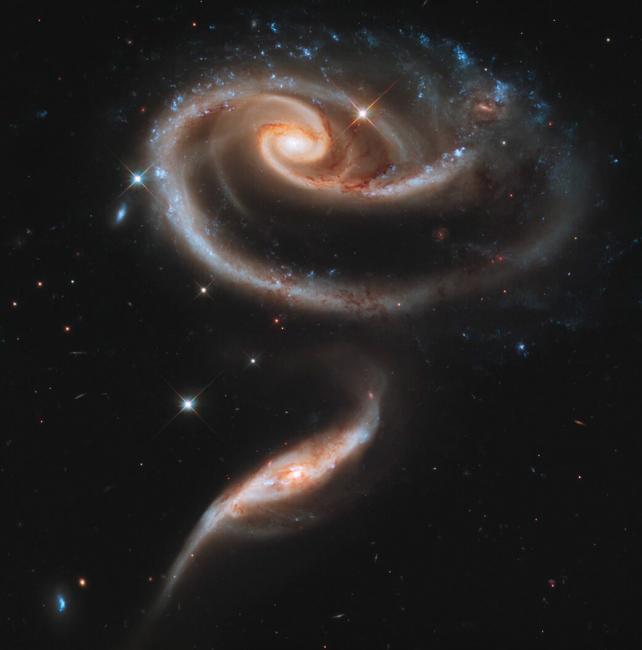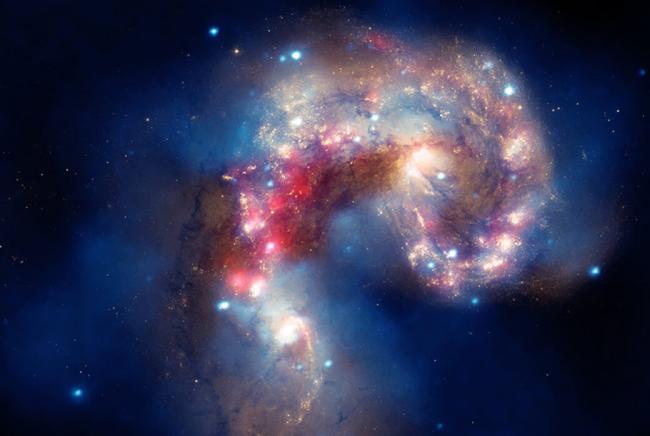Why do galaxies differ so much in size, shape, composition and activity?
Scientists now estimate that there are over a trillion galaxies in the Universe. Many follow broad classification patterns, but no two are exactly alike. The variety of galaxies we see gives us a picture of a richly differentiated universe. A key question is: why?
Our Work
The physical processes involved in galaxy formation and evolution form an incredibly complex puzzle, operating at a extraordinary scale. Scientists at the Institute for Theory and Computation (ITC) are working on this puzzle by combining simulations with real world observations to piece together the history of the Universe and to predict the fate of galaxies like the Milky Way.
Our Milky Way and the Andromeda Galaxy are giant spiral galaxies hurtling towards each other at 120 kilometers per second. In about 4 billion years, the two will meet. But while galaxies contain stars, gas, dust, and dark matter, they’re mostly empty space. These two ghostly giants will pass through each other, but their gravity will stretch and pull the other until they merge into one massive elliptical galaxy.
Astrophysicists believe that the Sun will be pushed to the outskirts of the new galaxy, known as Milkomeda, with a chance of being ejected into deep intergalactic space.
We see such mergers taking place today. The Antennae Galaxies are two spiral galaxies that have collided, resulting in increased star formation. It is believed that these galaxies will also eventually coalesce into a large elliptical galaxy. By studying the shape and history of galaxies, we are also studying our future.
What We Can See, and What We Can’t
The galaxies we can see with current technology, including NASA’s Hubble Space Telescope, are only a small fraction of all the galaxies in the Universe. This means that most of the galaxies in the Universe are too dim and distant to be seen with current telescopes, and that there were many more galaxies in the early Universe than there are now.
Scientists at the Center for Astrophysics | Harvard & Smithsonian are using the twin 6.5-meter Magellan telescopes in Chile and the 6.5-meter MMT Observatory in Arizona to look for these missing galactic progenitors. By combining these observations with advanced supercomputer simulations, we uncover how galaxies form, interact, and evolve over time.

Arp 273 is a pair of spiral galaxies, which may have collided in the past. Their gravitational interaction pulled the galaxies into the sweeping shapes we see; it also produced a burst of star formation, which is visible as blue splotches in the spiral arms of both galaxies.
What We Know About Galaxies
Edwin Hubble, namesake of the Hubble Space Telescope, developed a classification of galaxy shapes, or morphologies, in 1926 that is still widely used today. He categorized galaxies in three ways:
-
Spiral: Galaxies such as our own Milky Way that have a recognizable disklike shape, with arms that spread out from a rotating galactic center.
-
Elliptical: Galaxies that form a single, signature ovoidal cloud, with irregular rotations.
-
Irregular: Galaxies that hold to no particular recognizable shape or structure with no nucleus or discernible rotation pattern, essentially chaotic blobs of stars.
Galaxies change over hundreds of millions of years, and we can’t see a timelapse play out in our observations of the Universe. However, scientists have made great strides in theoretical and computational modelling of galaxies as they change over these long timescales, enabling our understanding of galaxy evolution to constantly progress.

The Antennae Galaxies have been colliding and merging into a single galaxy for roughly 100 million years. This image combines X-ray, infrared, and visible light to show how the collision is making new stars and churning the gas in the galaxies into marvelous shapes.
- Quasars & Other Active Black Holes
- Starburst Galaxies
- Supernovas & Remnants
- Machine Learning
- Extragalactic Distance Scale
- Astrostatistics
- Galaxies - Merging and Interacting
- Galaxy Clusters
- Galaxy Formation and Evolution
- Gravitational Lensing
- Intergalactic Medium
- Interstellar Medium and Molecular Clouds
- Large Scale Structure
- Very Long Baseline Interferometry
- The Milky Way Galaxy
- Extragalactic Astronomy
- The Energetic Universe
- Cosmology
- Computational Astrophysics
Related News
Chandra X-Ray Observatory Captures Breathtaking New Images
Astronomers Discover Rare Distant Object in Sync with Neptune
CfA Celebrates 25 Years with the Chandra X-ray Observatory
Unexpectedly Massive Black Holes Dominate Small Galaxies in the Distant Universe
Distant Stars Spotted for the First Time in the Vast Magellanic Stream
CfA Scientists Help Reach New Milestone in Quest for Distant Galaxies
The Tilt in our Stars: The Shape of the Milky Way's Halo of Stars is Realized
JWST Draws Back Curtain on Universe's Early Galaxies
Dozens of Newly Discovered Gravitational Lenses Could Reveal Ancient Galaxies and the Nature of Dark Matter
A Massive Galaxy Supercluster in the Early Universe
Projects
2MASS Redshift Survey
AstroAI
GMACS
For Scientists
James Webb Space Telescope Advanced Deep Extragalactic Survey (JADES)
Sloan Digital Sky Survey (SDSS)
The H3 Stellar Spectroscopic Survey
CASTLES Survey
Telescopes and Instruments
1.2 Meter (48-inch) Telescope
Visit the 1.2-Meter (48 Inch) Telescope Website
1.5-meter Tillinghast (60-inch) Telescope
CfA Operated (OIR) | Open to CfA Scientists | Active
Visit the 1.5 Meter (60 Inch) Tillinghast Telescope Website
Arcus
See Arcus Website
Chandra
Visit the Chandra Website
Einstein Observatory
Lynx X-Ray Observatory
Visit the Lynx X-Ray Observatory Website
Magellan Telescopes
Visit the Magellan Telescopes Website
MicroObservatory Telescope Network
Visit the MicroObservatory Telescope Network Website
MMT Observatory
Visit the MMT Website
Pan-STARRS-1 Science Consortium
Visit the Pan-STARRS1 Science Consortium Website
Spitzer Space Telescope
Visit the Spitzer Space Telescope IRAC Page
The 1.2 Meter Millimeter-Wave Telescope
Visit the MWT Website
Uhuru
Very Energetic Radiation Imaging Telescope Array System (VERITAS)
Visit the VERITAS Website